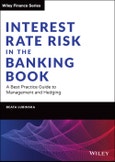Introduces practical approaches for optimizing management and hedging of Interest Rate Risk in the Banking Book (IRRBB) driven by fast evolving regulatory landscape and market expectations.
Interest rate risk in the banking book (IRRBB) gained its importance through the regulatory requirements that have been growing and guiding the banking industry for the last couple of years. The importance of IRRBB is shifting for banks, away from ‘just’ a regulatory requirement to having an impact on the overall profitability of a financial institution. Interest Rate Risk in the Banking Book sheds light on the best practices for managing this importance risk category and provides detailed analysis of the hedging strategies, practical examples, and case studies based on the author’s experience. This handbook is rich in practical insights on methodological approach and contents of ALCO report, IRRBB policy, ICAAP, Risk Appetite Statement (RAS) and model documentation. It is intended for the Treasury, Risk and Finance department and is helpful in improving and optimizing their IRRBB framework and strategy. By the end of this IRRBB journey, the reader will be equipped with all the necessary tools to build a proactive and compliant framework within a financial institution.
- Gain an updated understanding of the evolving regulatory landscape for IRRBB
- Learn to apply maturity gap analysis, sensitivity analysis, and the hedging strategy in banking contexts • Understand how customer behavior impacts interest rate risk and how to manage the consequences
- Examine case studies illustrating key IRRBB exposures and their implications
Written by London market risk expert Beata Lubinska, Interest Rate Risk in the Banking Book is the authoritative resource on this evolving topic.
Table of Contents
Preface vii
About the Website viii
Introduction 1
Chapter 1 What is IRRBB and why is it important? 6
Subcategories of interest rate risk 8
Regulatory overview for IRRBB - what has changed? 17
ECB 2017 IRRBB stress test 21
Interest rate shocks 24
Chapter 2 How to identify and measure Interest Rate Risk in the Banking Book 29
Identification of IRRBB - case studies of the exposure to IRRBB 29
The dual nature of IRRBB 44
Exposure to short-term
interest rate risk - maturity gap analysis 45
Maturity gap analysis from the economic value perspective 63
Time bucket sensitivity analysis - PV01 68
Duration gap analysis 69
IRRBB metrics 73
Credit Spread Risk in the Banking Book (CSRBB) 81
Chapter 3 How to manage IRRBB 84
Hedging instruments for IRRBB 84
Why consider interest rate swaps? 98
Natural hedging and hedging through derivatives 98
Hedging strategies 103
Chapter 4 Behaviouralisation of items without deterministic maturity and their impact on IRRBB 117
The significance and impact of behavioural issues in the banking book 117
The reason for modelling CASA under IRRBB 118
The impact of early redemption of fixed rate assets on IRRBB 121
Basic approaches for the modelling of NMDs 121
Basic approaches for the modelling of statistical prepayment on the asset side 130
Model risk 133
Chapter 5 Interest rate risk and asset liability management 136
Management of IRRBB under strategic ALM - proactive management of IRRBB 136
Setting up the target profile and integrated management of liquidityand interest rate risk through the application of numerical optimisation technique 143
Setting up the funding strategy for a bank taking into consideration the hedging requirements 149
IRRBB and funds transfer pricing 153
Comprehensive and feasible IRRBB strategy 171
Management of the intragroup interest rate risk 172
Chapter 6 IRRBB stress test, reverse stress test and ICAAP 175
IRRBB stress testing 175
ICAAP - assessment of the internal capital to cover IRRBB 185
Chapter 7 IRRBB governance and framework 190
Risk Appetite Statement (RAS) 190
Appendix 1: Example of IRRBB policy aligned with the requirements of BCBS Standards 197
Appendix 2: Example of IRRBB model manual 211
References 239
Index 241








